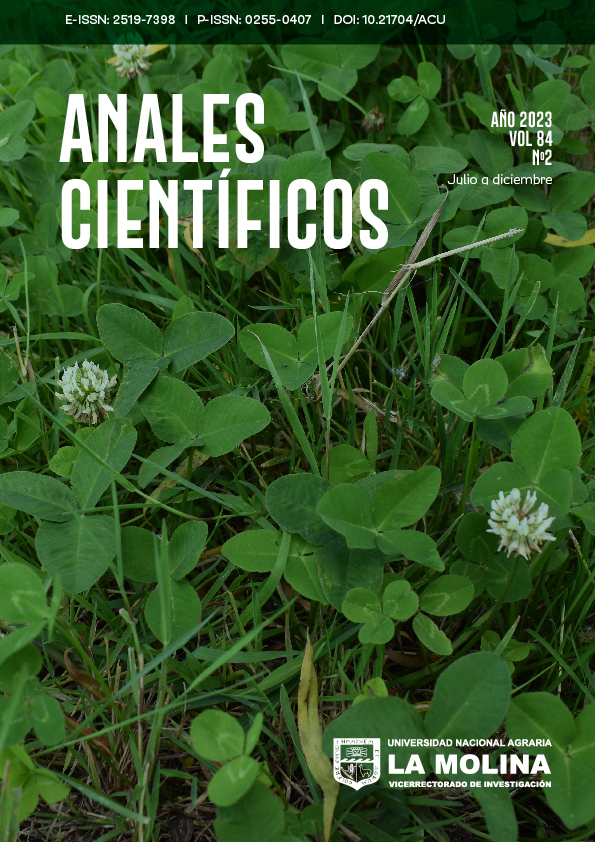Effect of particle size and temperature on aguaje (Mauritia flexuosa) peel flour and application in cookies
DOI:
https://doi.org/10.21704/ac.v84i2.1924Keywords:
Mauritia flexuosa, dietary fiber, total polyphenols, aguaje byproductosAbstract
Aguaje (Mauritia flexuosa) is one of the most consumed fruits in the Peruvian Amazon, mainly in the preparation of ice creams. One of the residues is the shell, which has sensory characteristics mainly of hardness. The main objective of this work was to evaluate the effect of temperature and particle size in obtaining water shell flour, and its application in cookies, in order to take advantage of this residue. The aguaje shell was separated, dried, ground, and roasted at different temperatures (120, 130, and 140°C), and then pulverized. The total polyphenol content of the ground and pulverized flours was measured. The flour with the highest polyphenol content was characterized in crude fiber and dietary fiber and selected to make cookies. These cookies were made with four levels of substitution (8, 10, 15 and 20%) and were evaluated for general acceptability by end consumers. Likewise, the compressive strength was measured instrumentally. The flour with the highest polyphenol content was toasted at 120°C and pulverized, and in the preparation of cookies it was possible to replace up to 15% with a good acceptability on average and an appropriate hardness. In conclusion, it can be affirmed that the lower roasting temperature and the reduction in particle size (pulverization) improve the extraction of polyphenols in the process of obtaining aguaje shell flour, with a high fiber content and that can be applied in biscuits with an acceptable sensory acceptance.
Downloads
References
Abreu-Naranjo, R., Paredes-Moreta, J.G., Granda-Albuja, G., Iturralde, G., González-Paramás, A.M., & Alvarez-Suarez, J.M. (2020). Bioactive compounds, phenolic profile, antioxidant capacity and effectiveness against lipid peroxidation of cell membranes of Mauritia flexuosa L. fruit extracts from three biomes in the Ecuadorian Amazon. Heliyon, 6(10), e05211. https://doi.org/10.1016/j.heliyon.2020.e05211
Aguero, S., Brítez, L., & Reckziegel, Y. (2022). Incorporación de harinas no convencionales derivadas de frutas en un producto de panificación. Revista Impacto En Ciencia y Tecnología, 2(1), 16–28. https://revistas.uni.edu.py/index.php/impacto/article/view/354
AOAC. (2019). Official Methods of Anlysis (21st ed.). Association of Official Analytical Chemist.
Arora, A., & Camire, M.E. (1994). Performance of potato peels in muffins and cookies. Food Research International, 27(1), 15–22. https://doi.org/10.1016/0963-9969(94)90173-2
Barboza, N.L., Cruz, J.M. dos A., Corrêa, R.F., Lamarão, C.V., Lima, A.R., Inada, N.M., Sanches, E.A., Bezerra, J. de A., & Campelo, P.H. (2022). Buriti (Mauritia flexuosa L. f.): An Amazonian fruit with potential health benefits. Food Research International, 159, 111654. https://doi.org/10.1016/J.FOODRES.2022.111654
Best, I., Casimiro-Gonzales, S., Portugal, A., Olivera-Montenegro, L., Aguilar, L., Muñoz, A.M., & Ramos-Escudero, F. (2020). Phytochemical screening and DPPH radical scavenging activity of three morphotypes of Mauritia flexuosa L.f. from Peru, and thermal stability of a milk-based beverage enriched with carotenoids from these fruits. Heliyon, 6(10), e05209. https://doi.org/10.1016/J.HELIYON.2020.E05209
Calderón, V., & Noriega, V. (2017). Obtención de harina de los residuos de frutas con mayor poder antioxidante y antimicrobiano (maracuyá, cacao y plátano) [Trabajo de Titulación para obtener el título de Ingeniero Químico]. Universidad Estatal de Guayaquil.
Cândido, T.L.N., Silva, M.R., & Agostini-Costa, T.S. (2015). Bioactive compounds and antioxidant capacity of buriti (Mauritia flexuosa L.f.) from the Cerrado and Amazon biomes. Food Chemistry, 177, 313–319. https://doi.org/10.1016/J.FOODCHEM.2015.01.041
Contreras, L. (2005). Desarrollo de una galleta dulce enriquecida con harina de quinua blanca (Chenopodium quinoa) utilizando diseño de mezclas [Tesis para optar el título de Ingeniero en Industrias Alimentarias]. Universidad Nacional Agraria La Molina.
Ćujić, N., Šavikin, K., Janković, T., Pljevljakušić, D., Zdunić, G., & Ibrić, S. (2016). Optimization of polyphenols extraction from dried chokeberry using maceration as traditional technique. Food Chemistry, 194, 135–142. https://doi.org/10.1016/j.foodchem.2015.08.008
Jovanović, A. A., Djordjević, V. B., Petrović, P.M., Pljevljakušić, D.S., Zdunić, G.M., Šavikin, K.P., & Bugarski, B.M. (2021). The influence of different extraction conditions on polyphenol content, antioxidant and antimicrobial activities of wild thyme. Journal of Applied Research on Medicinal and Aromatic Plants, 25, 100328. https://doi.org/10.1016/J.JARMAP.2021.100328
Larrauri, J.A. (1999). New approaches in the preparation of high dietary fibre powders from fruit by-products. Trends in Food Science & Technology, 10(1), 3–8. https://doi.org/10.1016/S0924-2244(99)00016-3
Li, S., Zhu, L., Wu, G., Jin, Q., Wang, X., & Zhang, H. (2022). Relationship between the microstructure and physical properties of emulsifier based oleogels and cookies quality. Food Chemistry, 377, 131966. https://doi.org/10.1016/J.FOODCHEM.2021.131966
Lucini Mas, A., Brigante, F.I., Salvucci, E., Ribotta, P., Martinez, M.L., Wunderlin, D.A., & Baroni, M.V (2022). Novel cookie formulation with defatted sesame flour: Evaluation of its technological and sensory properties. Changes in phenolic profile, antioxidant activity, and gut microbiota after simulated gastrointestinal digestion. Food Chemistry, 389, 133122. https://doi.org/10.1016/J.FOODCHEM.2022.133122
Melgarejo, S. (2018). Uso de residuos sólidos de la industrialización del camu camu (Myrciaria dubia H.B.K. Mc Vaugh) para la extracción de compuestos fenólicos [Tesis para optar el grado de Magister Scientiae]. Universidad Nacional Agraria La Molina. https://hdl.handle.net/20.500.12996/3154
Resende, L.M., Franca, A.S., & Oliveira, L.S. (2019). Buriti (Mauritia flexuosa L. f.) fruit by-products flours: Evaluation as source of dietary fibers and natural antioxidants. Food Chemistry, 270, 53–60. https://doi.org/10.1016/J.FOODCHEM.2018.07.079
Rudke, A. R., Mazzutti, S., Andrade, K.S., Vitali, L., & Ferreira, S.R.S. (2019). Optimization of green PLE method applied for the recovery of antioxidant compounds from buriti (Mauritia flexuosa L.) shell. Food Chemistry, 298, 125061. https://doi.org/10.1016/J.FOODCHEM.2019.125061
Singleton, V. L., & Rossi, J. A. (1965). Colorimetry of Total Phenolics with Phosphomolybdic-Phosphotungstic Acid Reagents. American Journal of Enology and Viticulture, 16(3), 144–158. https://doi.org/10.5344/AJEV.1965.16.3.144
Downloads
Published
Issue
Section
License
Copyright (c) 2023 Silvia Virginia Melgarejo Cabello, Viviana Quintanilla, Shallinny Ramírez Vásquez, Vladimir Reátegui Isla, Eduardo Reynaldo Morales-Soriano

This work is licensed under a Creative Commons Attribution 4.0 International License.






